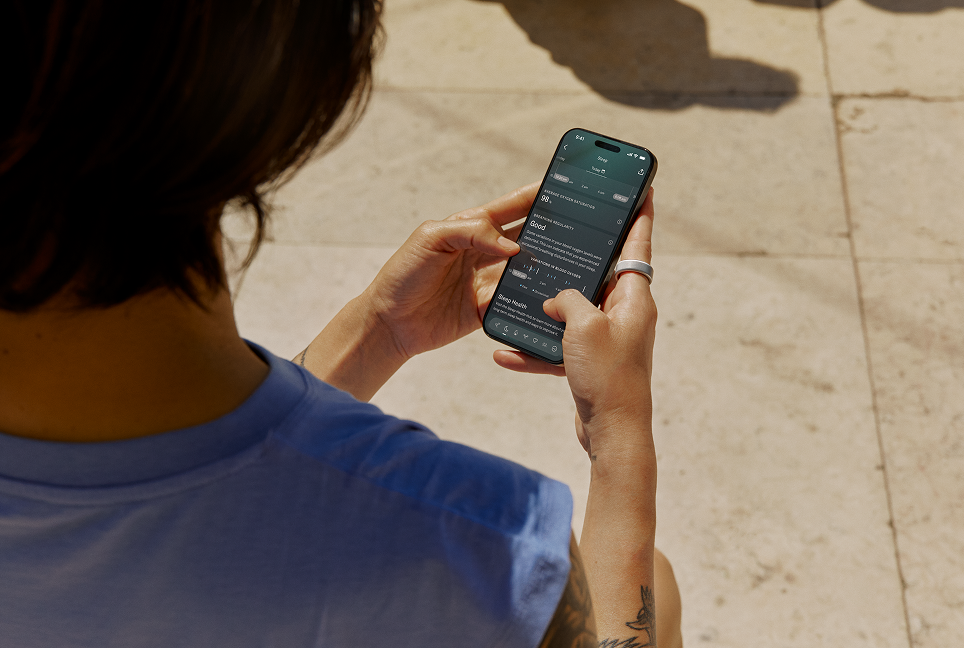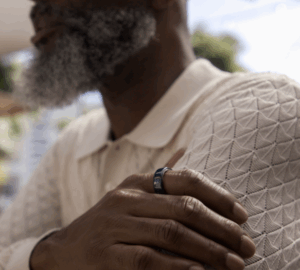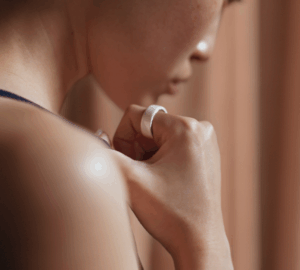With Blood Oxygen Sensing, your Oura Ring analyzes and reports two key insights: your Average Blood Oxygen and your Breathing Regularity while you sleep. While the Average Blood Oxygen feature measures the percentage of oxygen in your blood, the Breathing Regularity feature can detect unusual breathing patterns throughout the night.
“By continuously tracking and quantifying changes in blood oxygen levels in addition to heart rate, heart rate variability, breathing rate, temperature, and movement, the Oura Ring will now be able to provide a more comprehensive assessment of sleep health and physiology,” says Shyamal Patel, Ph.D., Head of Science at Oura. “Building this feature took a lot of creativity, innovation, and hard work from Oura’s R&D teams for more than a year, and we are thrilled to put it in the hands of our members.”
What Does Blood Oxygen Sensing Measure?
Oura’s Blood Oxygen Sensing feature detects the level of oxygen in your blood. As you may already know, oxygen is essential for our entire body. “When we breathe, oxygen travels into the lungs, then into the bloodstream,” says sleep researcher Rebecca Robbins, Ph.D., Oura advisor. “The entire body needs oxygen to function properly.”
Typically, healthy blood oxygen levels are between 95% and 100%. (Check with your doctor to confirm what ranges are healthy for you.) “If your oxygen levels are typically above 95%, this is a metric you probably don’t need to be vigilant about checking daily,” says Robbins. “However, it can be illuminating if your levels are below 95%, and a sign to speak to your healthcare provider.”
What Causes Low Blood Oxygen Levels?
Some common causes of low blood oxygen levels include:
- Lack of environmental oxygen, such as at high altitudes
- Lung disease such as asthma
- Sleep apnea, a sleep disorder characterized by blockages in the throat
- Heart disease
- Certain medications
- Alcohol use
Robbins notes: “If you see lower-than-usual levels of blood oxygen, it could suggest that your circulatory system and/or lungs are not working properly, which could lead to health complications if not addressed.” Note that metrics provided by your Oura Ring are not meant to diagnose any of these conditions, but rather provide helpful information that you can share with your healthcare provider.
How Oura Measures Blood Oxygen Levels
Your Oura Ring measures your blood oxygen levels by utilizing the red and infrared LED sensors added in the Oura Ring Gen3 and Oura Ring 4. The sensors shine red and infrared light into your finger and use the reflected light that bounces back to estimate how much oxygen is in your blood. Richly oxygenated blood reflects more red light than infrared light, while poorly oxygenated blood reflects more infrared light than red light.
Note that Average Blood Oxygen and Breathing Regularity are measured during sleep periods longer than three hours.
How to Improve Blood Oxygen Levels
Using your Oura Ring to track your Average Blood Oxygen can empower you to improve your levels over time by picking up healthy lifestyle behaviors, like regular walks outdoors and breathing exercises, Robbins says. Here are a few tips to improve your blood oxygen levels:
- Simply breathe. It’s something you do every day without even thinking about it, but there are ways to enhance your breathing to up your oxygen levels. You can try a simple breathwork exercise, like square breathing or a progressive muscle relaxation, Dr. Robbins suggests. Access guided audio versions of these, plus a wide range of simple breathwork exercises, in the Explore content on your Oura App.
- Take a walk. Walking outdoors can help fill your lungs with fresh air and oxygenate your blood.
- Don’t smoke. If you smoke, quitting smoking can help increase your blood oxygen levels.
- Maintain a healthy diet. Ensure you’re getting adequate iron in your diet, which is essential for physiological processes, such as oxygen transport throughout the body, Robbins says.
- Talk to your doc. “If you suspect you might have a medical condition such as sleep apnea, work with your doctor to determine measures to improve your signs and symptoms,” Robbins suggests. Sleep apnea is usually improved with lifestyle changes — most often losing weight, quitting smoking, or treating allergies — but more serious sleep apnea may require a CPAP machine.
LEARN MORE: 10 Ways to Increase Your Blood Oxygen (SpO2) Levels
What Does Breathing Regularity Mean?
Along with Blood Oxygen Sensing, the new Breathing Regularity feature tells you how many suspected disturbances — or observable drops in your average blood oxygen levels — were detected during your sleep. (Note: This is not the same as respiratory rate. Breathing Regularity reflects changes in how much oxygen is present in the blood. Respiratory Rate measures the rate at which you take breaths, and reports as breaths per minute.)
Breathing disturbances can occur when the muscles in the roof of your mouth, tongue, and throat relax, partially causing a blockage in your airway and resulting in lower oxygen intake. These disturbances can be caused by factors such as alcohol use, sleeping on your back, congestion, illness, or a sleep disorder known as sleep apnea, among other health conditions.
Keep in mind:
- Most people’s blood oxygen levels are healthy and normal, and many can expect an Optimal or Good score on Breathing Regularity to remain consistent over time.
- Pregnancy and some medical conditions, like allergies, may affect the accuracy of breathing regularity sensing.
- Make sure your ring’s sensors are on the underside of your finger, and your ring fit feels snug.
- It is usual to have some breathing disturbances, especially during REM sleep. Keep an eye on your long-term breathing regularity, rather than just one night’s data.
How to Improve Your Breathing Regularity
- Upgrade your sleeping ergonomics. Make sure your mattress and pillow support your neck and spine while you sleep. Sleeping on your side with a supportive pillow may help improve your sleep quality. Breathing through your nose can also help.
- Try sleeping on your left side if you suffer from reflux or heartburn.
- Ensure your sleeping environment is as quiet, dark, cool, and ventilated as possible. Using ear plugs, socks, and a sleep mask may help you to fall asleep.
- Meditate before bed. Try to clear your mind from the day’s events, and practice self-compassion. For more help winding down, check out sleep meditations in Explore content.
Using the Blood Oxygen Sensing Feature

These two new features, Average Blood Oxygen and Breathing Regularity, are turned on by default. To toggle them on or off, go to “Blood Oxygen Sensing” in the main menu.
To find your Average Blood Oxygen percentage and Breathing Regularity display, tap the Sleep tab after your next sleep period of more than three hours.
Suspected variations in your blood oxygen levels are shown in a color-coded timeline. Each line in the timeline represents a 15-minute interval, during which variations can be noted as few (dark blue), occasional (light blue), or frequent (white).
Depending on the number of variations observed throughout the night, your Breathing Regularity will be categorized as:
- Optimal: no significant variations to display
- Good: few variations detected (dark blue line)
- Fair: occasional variations detected (light blue line)
- Pay attention: frequent variations detected (white line)
For most people whose blood oxygen levels are healthy and normal, you can expect your Optimal, Fair, or Good score on Breathing Regularity to remain consistent over time. Note that if your blood oxygen levels are measured as “Optimal” throughout the night, the Oura App will not display a breathing regularity timeline.
Your ring’s battery life may be a bit shorter than usual due to the additional ring sensors now being operated. You can toggle SpO2 monitoring off in your Settings if you prefer. Remember to charge your ring before bed if the battery is below 30% — turn on your low battery notifications as a reminder!
Learn more about these features, and how to troubleshoot, here.
Become an Oura Member: Shop the new Oura Ring 4.
About the Oura Experts
Shyamal Patel, Ph.D., is the Head of Science at Oura, where he leads an interdisciplinary organization focused on research and development of algorithms that translate sensor data into accurate measures of health and wellbeing. He is passionate about building digital health solutions that enable the transformation of healthcare from a largely subjective, episodic, and reactive model to become more objective, continuous, and proactive. Before Oura, Shyamal has led data science teams in several startups as well as large companies. Most recently he was at Pfizer where his work was focused on development, validation, and deployment of new digital endpoints across multiple therapeutic areas in regulated clinical trials. Shyamal has a PhD in electrical engineering with a specialization in signal processing and applied machine learning from Northeastern University. He completed his post-doctoral research at Harvard University and lives in Boston.
Rebecca Robbins, Ph.D., is an Instructor in Medicine at Harvard Medical School and an Associate Scientist at the Brigham and Women’s Hospital. Her research uses marketing and novel communication tools and technologies (i.e. smartphones and other mobile devices) to design persuasive behavior change interventions to improve sleep and circadian health. In 2011, Dr. Robbins co-authored Sleep for Success! with Dr. James B. Maas. Dr. Robbins’ research has appeared in the New York Times, the Financial Times, and Readers’ Digest, and she has appeared on The Today Show, Live! With Kelly Ripa and Ryan Seacrest, Fox Business News, ABC Nightline, CNBC, and CBS This Morning.










